Thursday 14th April 2022

There’s a lovely hamlet in Essex called Good Easter.

Located in rural Essex between Chelmsford and Braintree it just happens to fall into one of the two areas covered by Essex County Council’s brand new DigiGo branded DRT scheme which began this month and was officially launched yesterday.

It seemed like too good an opportunity to miss to have both a seasonal outing and check out another new DRT operation set up thanks to funding from the DfT’s Rural Mobility Fund.
Essex received two awards from the Fund. Central Essex, which includes Good Easter (and another hamlet called High Easter) got £1,493,000 while an area called South Braintree gained £1,082,000. Both areas are very rural with minimal or no bus provision.

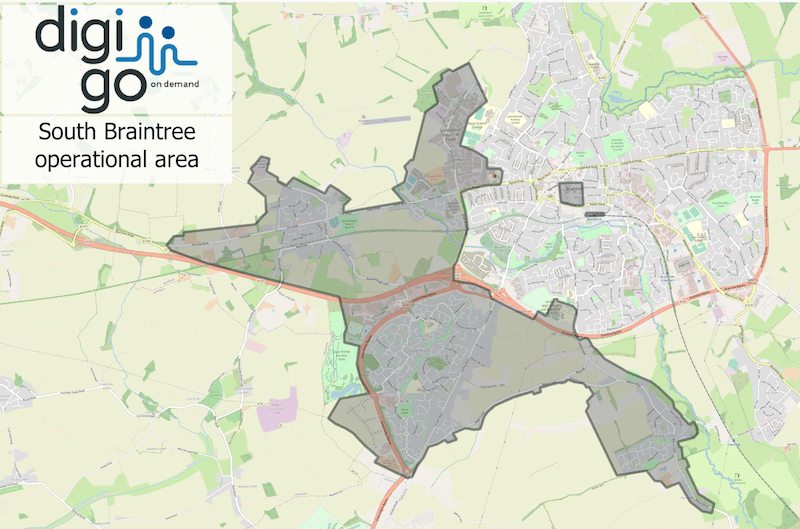
Although both schemes are portrayed as separate entities when passengers book with separate maps and journeys are restricted to one or the other area the overall DigiGo operation is run in house by the County Council as one unit utilising six minibuses and employing 22 drivers.
The number of drivers may appear high but the hours of operation are quite extensive being 07:00 to 22:00 and daily too. I’ve not come across a DRT scheme offering such extended hours so far, so Essex are certainly trail blazing extensive coverage.
Essex are also trail blazing electric/battery minibuses on DigiGo. The only other DRT scheme using electric vehicles is in East Leeds and branded ‘Flexibus’, as regular readers may recall. The vehicles used on DigiGo are manufactured by SAIC, the largest automotive company in China and the name behind the LDV brand now heavily into light commercial vehicles running as either EV, hybrid or hydrogen. The range of the six LDVs being used is not huge at about 120 miles meaning at least one mid-shift charge is going to be necessary especially once the operation gets busier. But the vehicles use the nearby substantial Gridserve all electric service station situated on the A131 south east of Braintree which has fast charging infrastructure as a model for future roadside facilities of this kind.
Essex are using its already established Moovit run ‘Travel Essex’ app which offers information and journey planning about all travel modes across the county and through which you book a ride with DigiGo rather than a bespoke app as most schemes use.
The odd thing I found about that is if you put in a journey from say the Chelmer Valley Park & Ride site near Little Waltham (situated to the north of Chelmsford) and give your destination as Good Easter it will come up with convoluted options using conventional bus routes and list them first – even including an option involving a five mile walk taking an estimated hour and 42 minutes in an overall journey time of 2 hours and 36 minutes. Oddly the 19 minute journey using DigiGo is listed further down the pecking order.

I came across the same problem when using the ‘ready2go’ scheme in Aberdeenshire which I guess also uses the Moovit software.
I can appreciate where traditional bus routes are available it makes sense to ‘nudge’ (or indeed compel) passengers to use them rather than DRT to make sure DRT is complimentary to the bus network but where DRT is the only realistic option, which for Good Easter it certainly is, then this should be listed prominently at the top. After all we should be doing everything to encourage take up of rural DRT which is what the Rural Mobility Fund is all about.
DigiGo really is a rural DRT – the Central Essex area covered pointedly doesn’t include Chelmsford itself and the South Braintree scheme only picks up/sets down at Braintree railway station or bus station as shown on the map above.
For Central Essex the idea is to bring people from their isolated villages and hamlets to the aforementioned Chelmer Valley Park & Ride site for onward travel into Chelmsford on the route 702 Park & Ride service.

Coincidentally the contract for this service has just recently changed hands with Vectare (yes, those young entrepreneurs are expanding again) taking over from First Essex. Vectare are waiting for their new fleet to arrive and in the meantime are operating some white liveried dealer stock on a temporary basis.

I’ve promised the guys at Vectare I’ll give their new buses a road test once they arrive and are in service in a few weeks time so I’ll report on this at a later date.

I ordered my DigiGo ride from the Park & Ride site over to Good Easter on Monday evening for a journey at 10:45 on Tuesday morning. And just to be sure ordered a return journey at 11:45 – I’m not going to get caught out with finding no mobile phone signal at my destination again!
The booking was straight forward (with reassuring confirmatory texts received) although I was a bit surprised at the price quoted on the app – £8 for the single journey – which admittedly would be cheaper than a taxi and frankly is much more realistic than other DRT schemes have been charging, with crazy low prices.

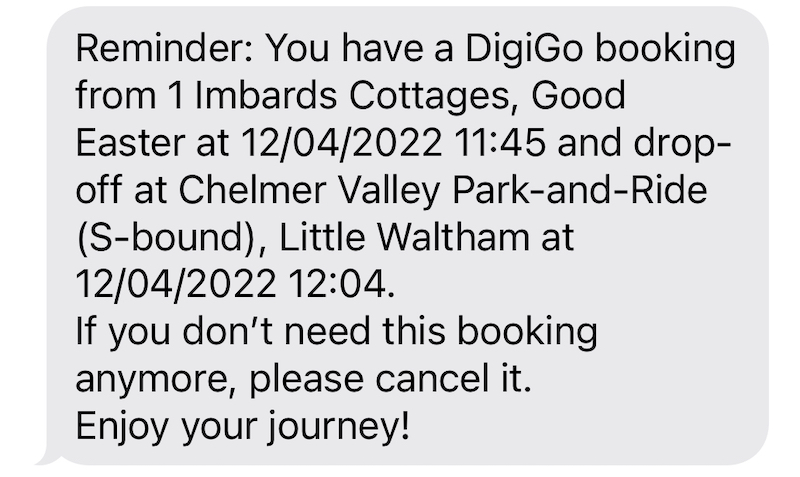
Booking for the first time required me to enter credit card details to set up an account (unlike ‘Felxibus+’ in Swaffham, drivers on DigiGo don’t handle transactions – it’s all done through the app) and only after that could I enter my concessionary pass details to qualify for free travel – which seemed a bit odd – but it was later explained to me that if I’d booked a journey before 09:30 on a weekday then the concessionary pass wouldn’t be valid, which is fair enough.
As I headed over to Chelmsford on Tuesday morning I noticed I’d received a text at 08:41 telling me my “ride is waiting for” me which was a bit disconcerting especially as when I replied it was obviously not a text number able to receive incoming messages.
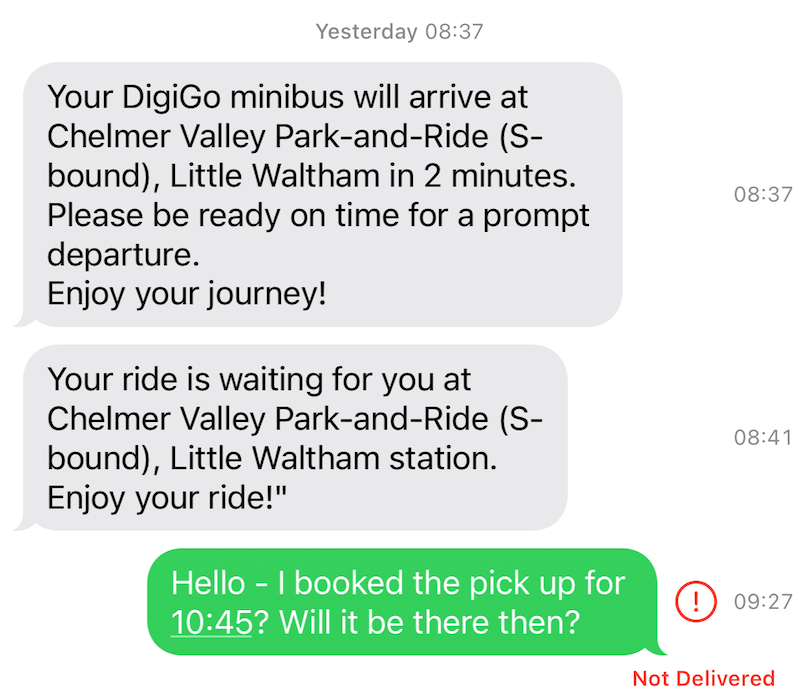
I crossed my fingers and hoped it was a technical teething glitch.
I arrived in good time at the Park & Ride site and spotted the DigiGo bus already on site waiting which was when I met Lynne who was my designated driver for both journeys.

Lynne showed me around the eight seater vehicle including the tail lift for passengers using a wheelchair – apparently two of the fleet are so equipped with this layout for wheelchairs with the other four having more seats in the flexible configuration.

For more able bodied passengers there’s a manually operated door and a retractable step to help you board the vehicle. It was fairly easy to get on board and off again for me, once I’d remembered to duck my head so as not to hit it on the roof.

Lynne is a brilliant ambassador for DigiGo with a delightful personality as well as being a superb driver along the narrow rural Essex lanes we travelled along to and from Good Easter. You really notice how you’re gliding so silently and smoothly along the road in the LDV.

We arrived in Good Easter after a 19 minute journey time exactly as the app had predicted and while Lynne went off to have her lunch break I explored the village.

It’s a lovely village-come-hamlet with no pub or shop (that I could find) but a nice church and plenty of attractive looking houses.

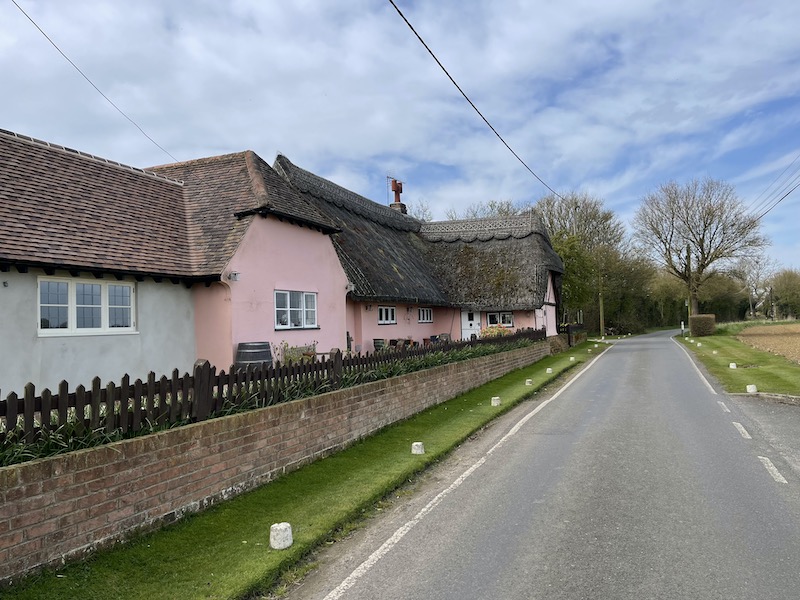
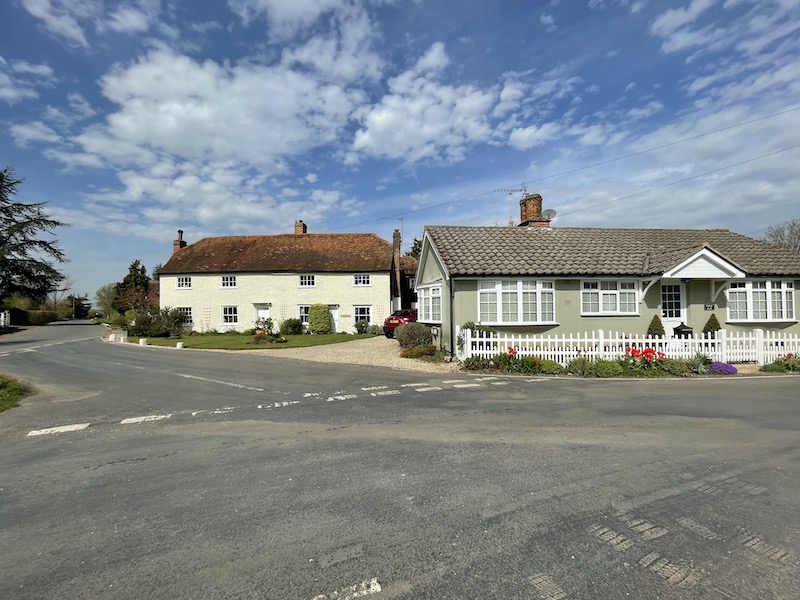
I came across a bus shelter in the centre of the village which has been repurposed as a Bus-Book-&-Information-Stop.

As well as library books and games, among the wealth of information on display were minutes of a recent Parish Council meeting (on 31st March) but interestingly no mention of DigiGo coming to the village. An opportunity for some promotion and awareness there.

Also included is a bus timetable for the one journey a day shopper bus into Chelmsford at 09:38 on TThFS.

My forty minute wander around Good Easter soon passed and it wasn’t long before Lynne returned and we headed back to Chelmer Valley Park & Ride.
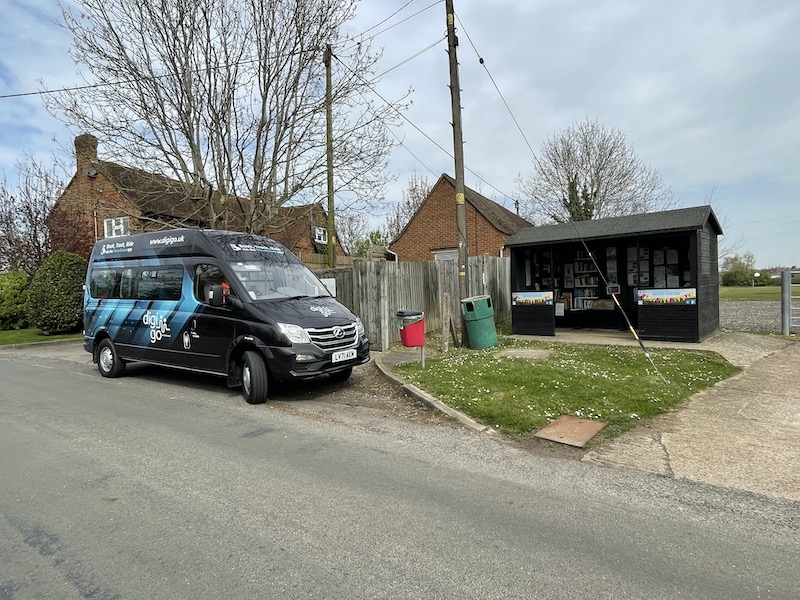
Another 19 minute ride and we were soon back at the Park & Ride site.

Interestingly when Lynne dropped me off on arriving earlier into Good Easter at 11:05 I received another misleading text telling me my “minibus will arrive in 2 minutes” and it seems there’s some kind of glitch in the software which sends an alert to the next passenger as soon as the previous journey has been completed if it’s from the same location – hence why I received the other earlier text when Lynne had completed a journey to Chelmer Valley at 08:41.

Another anomaly was on entering Good Easter as my desired destination into the app it defaulted to specifying this as 1 Imbards Cottages – a random address on the south edge of the hamlet – rather than the village centre by the aforementioned bus shelter and the rather nice village sign.

I understand this is to do with how Google maps and geo-fencing works and of course residents would almost certainly enter their postcode or full address and the software would show the nearest “virtual” bus stop. As a visitor all I could do was put the name of the village itself, although there is an option to use the map to specify the setting down/pick up point but I find my fat fingers don’t always get that right either.

These are all minor teething issues which I’m sure James Hopkins and his colleagues at Essex County Council will soon resolve. James is the County Council’s Transport Business Development Manager and got in touch with me a couple of weeks ago and kindly invited me over to try out the new service and emphasising how keen he was to hear my feedback as a user which is always an encouraging and impressive sign.
We had a good chat yesterday morning and I passed all the points mentioned in this blog to him and he was very eager to take note of them all and see what can be done to ensure they are dealt with. Plans for promoting the new scheme including a roadshow are in hand and I have to say this attitude was so encouraging to witness. It made my visit and report back feel worthwhile so a big thanks to James and to Lynne.
The challenge facing DigiGo (and many other rural DRT schemes being set up with the DfT’s funding) is villagers and hamlet dwellers are inevitably long established car dependent residents and it’s going to take a major shift to change habits, especially if it involves taking a change of bus to reach their destination (at the Park & Ride site). There’s always a sense of anxiety whether connections will work especially in the homeward direction but I can see the logic of not tying up more time and miles by sending the Central Essex minibuses into Chelmsford, especially with such a large rural area to cover.

As I found in Swaffham on Monday, these villages and hamlets have never had the opportunity to enjoy public transport provision now presented to them with these trial DRT schemes. Indeed my former colleague at Brighton & Hove, Tony Holden, also now retired, commented on my Swaffham blog that “even in the heyday of buses (1965) Cockley Cley only had 3 buses a week”.
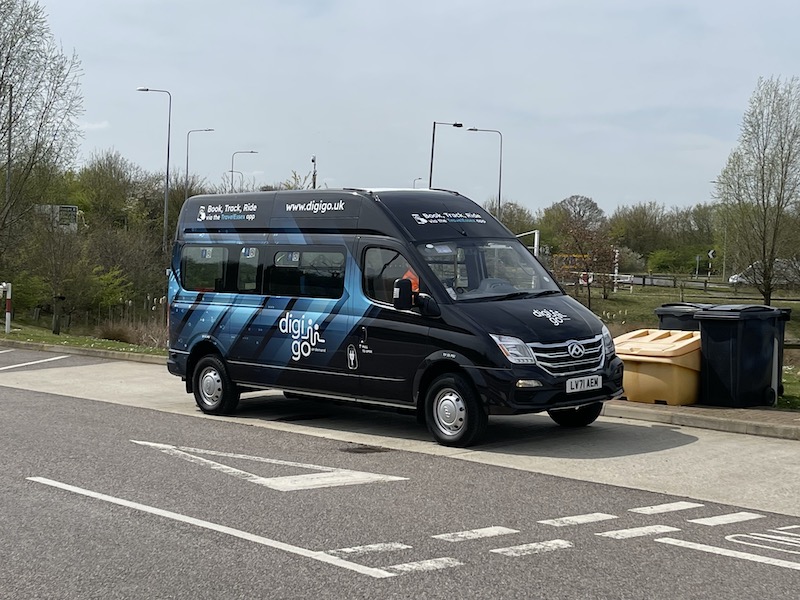
So there’s a golden opportunity now for people to make the switch and leave their expensive-to-run cars in the drive and summon up a rural minibus for their journey. With a daily service through until 22:00 young people will be able to go out in the evenings without the need to call on the Mum & Dad Taxi Company while concessionary passholders have a free to use taxi service as they need. The DfT funding for DigiGo is only for two years so it’s going to be a tough call to change habits and generate enough custom in that time and for Essex’s politicians to find the balance of subsidy it will surely need when that ends.
But with the positivity and dedication James conveyed to me and the wonderful service and welcome provided by Lynne, DigiGo is certainly in good hands and deserves to succeed to reward that commitment. Sadly, bearing in mind all the issues relating to DRT discussed in these blogs over the last few years, not least the significant financial commitment needed, and the logistics of serving a large sparsely populated area I doubt I’ll be able to make a return trip to celebrate Easter after 2024.
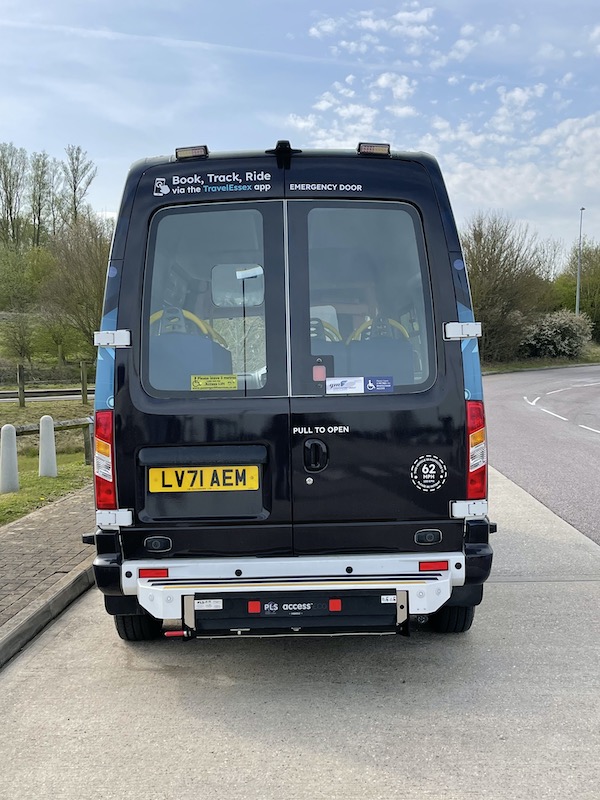
I hope readers have a Good Easter. I did.
Roger French
PS There are still many of the 17 DRT schemes being funded by the DfT’s Rural Mobility Fund yet to commence. If readers hear news of their introduction, do let me know – in Buckinghamshire, Cheshire West & Chester, Cumbria, Gloucestershire, Leicestershire, Nottinghamshire, Staffordshire and Wiltshire.
Blogging timetable: 06:00 TThS.


There’s a place called Cold Christmas near Ware, over the border in Hertfordshire – it used to amuse me when I passed it. Bussing between the two might be a bit of a struggle, though!
LikeLike
Even more amusing was Ugly evem more so when the local psper had a report from thr Uglu womans institute. I thing they do a mrs Boquet on the pronounciation
LikeLike
There’s an Easter Boleskine up in Scotland and it’s a hamlet on the east shore of Loch Ness reached by the Inverness to Upper Foyers bus which runs about 4 times a day.Easter Boleskine’s claim to fame,or maybe infamy,is the English occultist Aliester Crowley lived there and supposedly conjuringed up the Abra Melin demons there.In the 1970’s Jimmy Page of Led Zeppelin fame lived in Boleskine House.At some point it burnt down and has never been rebuilt.You can see the gate of Boleskine House now but nothing else.The Foyers Waterfall about 2km south is very impressive.I got stuck up there during the Beast from the East storm which was appropriate as the Edwardian press would call Aliester Crowley….the Beast 666!
LikeLiked by 1 person
Is it accurate to say the South Braintree area is “very rural, with minimal or no bus provision”?
LikeLike
Clearly the South Braintree area is relatively well served by bus services to the town centre, with Arriva 133 and Stephensons 9/9A running hourly, Stephensons 21 half-hourly and First Essex 70/A every 15 mins on weekdays and Sunday services on all except 9/9A. Presumably the intention is to provide links to non-town centre destinations not well-served by radial routes. Having said that, any trips to Braintree Bus or Rail stations are going to deprive the above-mentioned routes of revenue, which they sorely need at the moment.
LikeLike
There is a confusing collection of Dial A ride type service in Essex. There is also the Dart services. How they differ from the Digico services I have not a clue> Whether these services use the same app and phoner number I dont know. I am pretty sure the F315 does not
This looks as if it will suffer the normal problem of being to expensive. 6 buses and 22 drives is a very high overhead. I would guess some of the drivers are part time. Some basic sums suggest that it will never even reach break even. There are very rural areas. and at £8 if you already have a car you will use that
It could get some commuters by taking people to Harlow & Chelmsford. The £8 fare is less significant then as you would save on parking charges
One area where it could gain passengers would be to take people to Stansted but not sure if that’s in the operating areas. The map is not clear
There is the usual poor publicity and difficulty in even finding information on them. A mail shot might be one way to try to publicize it, To late now but it could say have been sent out with the Council tax bills but only to the postcodes where the service operates
https://www.essexhighways.org/getting-around/bus/community-transport/demand-responsive-transport-dart
There is also a strange hybrid service which is part normal bus service an part Pre book, It looks to be very confusing
Click to access 2021-12-01+-+Arrow+Taxis+-+F315.pdf
LikeLike
The Digigo link is here: https://www.essexhighways.org/getting-around/ddrtdigigo/digigo
I have found no decent map of the operating area so it is pretty much a guess. It does mention some places though.. Chelmsford is not i the operating area nor is Harlow or Braintree or Stansted. These are places people are likely to want to travel to. It just suggests traveling to a bus station and changing to a normal bus. I doubt though within those area there are any bus stations and I doubt anyone will bother if it does not go direct
There is a bus to Stansted from Chelmsford and Braintree but the Digi go apparently does not go to those two places. There is probably a local bus to Stansted from Bishops Stortford but that in another county so another detective job
LikeLike
It appears that your bus and driver spent just 38 minutes in service carrying passengers between 0841 and 1204 and Essex County Council received zero income as it would reimburse itself for your use of your ENCTS pass.
As for teenagers using the service to visit friends, are they, mum or dad going to fork out £16 for two fares to avoid getting the family taxi out? I doubt it.
LikeLiked by 1 person
Another odd thing which is quite typical of these DRT services is they are Not Lowe floor and they have a manually operated door. Given a substantial part of the market for these services is the elderly and disable it does not seem very sensible. The entrance also tends to be cramped making it difficult fort people with lots of shopping or shopping trollies. There is also very limited space for shopping. They really need to use more suitable vehicles in my view
LikeLike
There used to be an annual Blake Hall Easter Show on Eaater Mindays. That was at the actual hall, not the station. For several years a bus rally and running day became assiciated with it. However one year, Routemasters Ltd, operators of the H29 Trafalgar Sq to Hatfield Heath Routemaster operated night bus service, registered an 847 Blake Hall to Good Easter service. Mainly no doubt to be able to display the destination GOOD EASTER on the front of the Routemaster.
LikeLike
Probably planning some gold plated buses for the Chelmsford park n ride set despite the fact none of them ever put any money into proper public transport and never will while weapons like cars are legal.
LikeLike
Don’t make the mistake of thinking that DRT equals rural transport, however much you wish. Locals know it, even if the emmetts don’t. They appreciate it too, even when the emmetts don’t. History matters, it didn’t begin in the last couple of years.
LikeLike
Staffordshire Moorlands DRT has quietly been launched. It’s more of a extension of the long established Moorlands Connect, still using traditional ‘dial-a-ride’ booking style alongside the new app, which is the standard ‘via’ template.
https://moorlandsconnect.co.uk/
LikeLike
Many thanks for that info.
LikeLike
Why most DRT/Micro-Transits fail – What the survivors tell us about progress
In the UK 67% of DRT schemes have failed and elsewhere in the world things do not seem to be much better
It seems to confirm the views of many that DRT is not the answer
I suspect that those that do survive are niche market operation such as DRT services in the National Parks
It at least in my view throws serios doubts on the government and local councils throwing money at DRT schemes which are almost certain to lose money and eventually fail
Media often reports demand responsive transit (DRT) and ‘micro-transit’ (MT) as ‘re-inventing’ conventional fixed route transit but rarely report financial data on DRT/MT performance or note their high failure rates.
This paper reviews DRT/MT systems performance with particular focus on failure rates. Results show DRT is very failure prone; 50% last less than 7 years, 40% last less than 3 years, and about a quarter fail within 2 years. In the UK, 67% of DRTs have failed, and in Australasia, 54%. Results identify and explore three distinct phases of global DRT development since the 1970s; recent MT are most failure prone (50% fail within 2 years).
Results show a strong link between failure and higher costs. Specialist DRT services for disabled people were relatively cheaper while MT was found to have higher and increasing costs. Results imply simpler (e.g., many-to-few or route deviation) operations had lower failure rates compared to more complex many-to-many services.results.
Conclusions suggests that despite 40 years of experience, the high failure rate of DRTs suggest they are still a high cost, experimental, uncertain and unreliable solution for cities. The paper explores policy implications of these findings and areas for future research.conclusion.
https://www.sciencedirect.com/science/article/abs/pii/S0739885920300937#:~:text=Results%20show%20DRT%20is%20very%20failure%20prone%3B%2050%25,of%20DRTs%20have%20failed%2C%20and%20in%20Australasia%2C%2054%25.
LikeLike
I don’t know how RF does it but he gets to know about new services nearly as quick as us locals. The first indication we had was a piece in the local newspaper four days before RF took his trip.
I’m not sure that Good Easter would consider itself a hamlet, I would say it’s a fully fledged village. Actually RF should have gone to nearby High Easter instead.It has a nice cafe owned by J.W.Lodge & Sons and is next door to their bus garage that contains an excellent selection of Bedford OB and SB coaches not too mention their Ford Model T which is route branded for their 102 year old service to Chelmsford. When RF returns to the area to sample the Vectare P & R service perhaps he should try the Lodge service although I fear that it will be operated by something a little newer than the Model T.
Like Bob, I couldn’t find a good map of the DRT operating area. I even tried copying the ECC offering on to a local map of the South Braintree area but still couldn’t make sense of it despite having the benefit of my family having lived just north of Braintree for 250 years.
It’s interesting to note that a credit card is required to use the service. While I assume most younger people have one, I’ve never had one and I doubt I ever will given my advanced age. In fact I’ve only just acquired my first personal mobile phone and certainly wouldn’t know how to install an app.
Bob mentioned the F315 service from Halstead to Sudbury. This is a combination of an ordinary bus service and DRT which has fixed departure times from each terminal but the routing varies according to prebooked demand. It is more user friendly in that fares are paid in the normal way.
Nigel McBride is correct in saying that South Braintree has regular bus services but the No. 70 is being halved in frequency from April 17th by First Essex.
LikeLike
The difference between a village and a hamlet is a hamlet does not have a church
Probably nowadays quite a few villages have lost their churches but tend to remain being called a village so the difference now is a bit arbitary
LikeLike
A hamlet doesn’t have a church,a village generally does,a town a charter and a city a cathedral but some like Bath and Wells and Cambridge and Ely have a sort of joint cathedral.Modern cities are different and I don’t know why criteria they use for places like say Sunderland or Preston which generally just have the air of big towns.For example Sunderland feels just like Middlesbrough,a large town, and lacks the bohemian air of Newcastle…. pretty pointless making them cities.
LikeLike
Another interesting global review of DRT services
Click to access S2_Ponent-3_Roger-Teal_International-Status-of-DRT-with-FlexDenmark-emphasis.pdf
LikeLike
Another interesting article on DRT
https://www.ticketer.com/en/article/cpt-feature-demand-responsive-transport/
These articles tend to highlight the issues most poster her hve seen with tm which is high cost and lacl of flexibility. EAch DRT opration tends to be stand alone with its own vhicles own drivers and own garge which lead to bother under supply and over supply. THeu also have their own call centre and app adding even more to costs
There i no tral integration with rail or fixed route buses so you cannot book a though ticked. You also chance your liuck as to where it will connect with a fixed route bus many of which are very infrequent so you could end up stranded for an hour or two
LikeLike
In Switzerland DRT is only used for the most isolated communities. Most rural buses are fixed route services with timed connections between them and with trains. Because of the reliability of the connections passenger numbers are good, because of the greater choice of destinations available.
I believe the erstwhile Western Greyhound network used rural interchanges with timed connections, combined with economical Mercedes Varios.
In the USA smaller cities use what is known as the pulse system whereby relatively infrequent urban services connect at interchanges every hour enabling more choice of destinations.
LikeLike
There will be a program on Demand Responsive Buses on Radio 4 on Tuesday evening 26th April 2022, forget exact time, but will no doubt be in the listings soon.
LikeLike
It’s at 21:30. Thanks Brian.
LikeLike
Another DRT starting Monday 2nd May is the Berwickshire Pingo. This is operated by Borders Buses and whilst I have not yet seen details appears to cover the whole of Berwickshire. Perhaps one to try out after Reston Station opens on 23rd May?
LikeLike
Thanks for the info; will take a look some time. Thanks again.
LikeLike